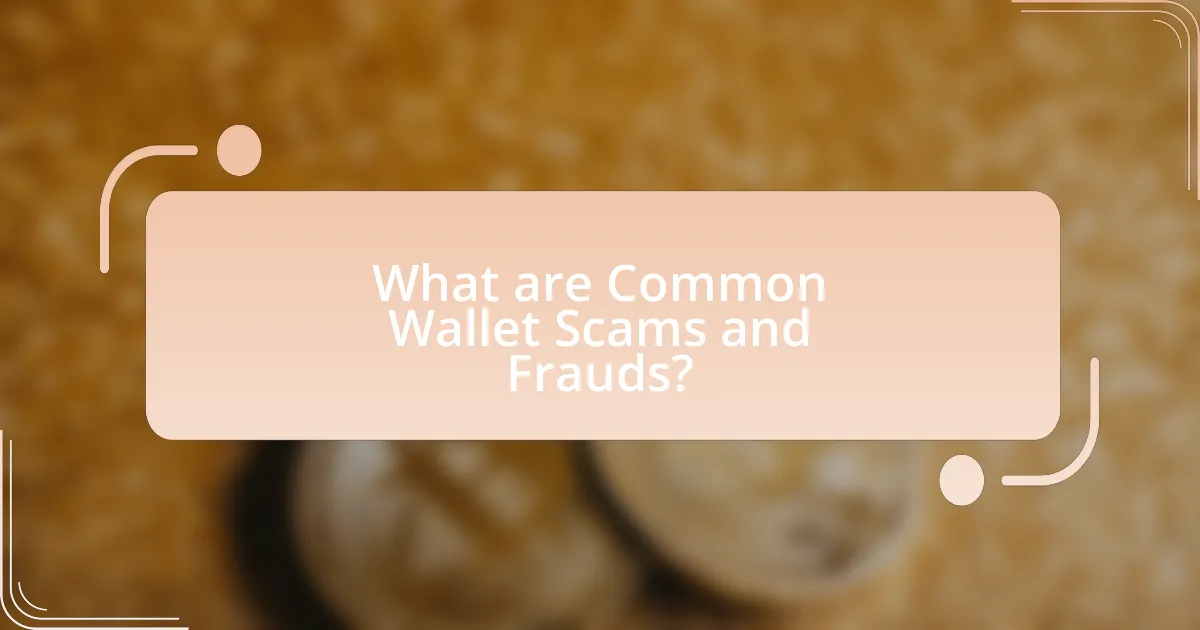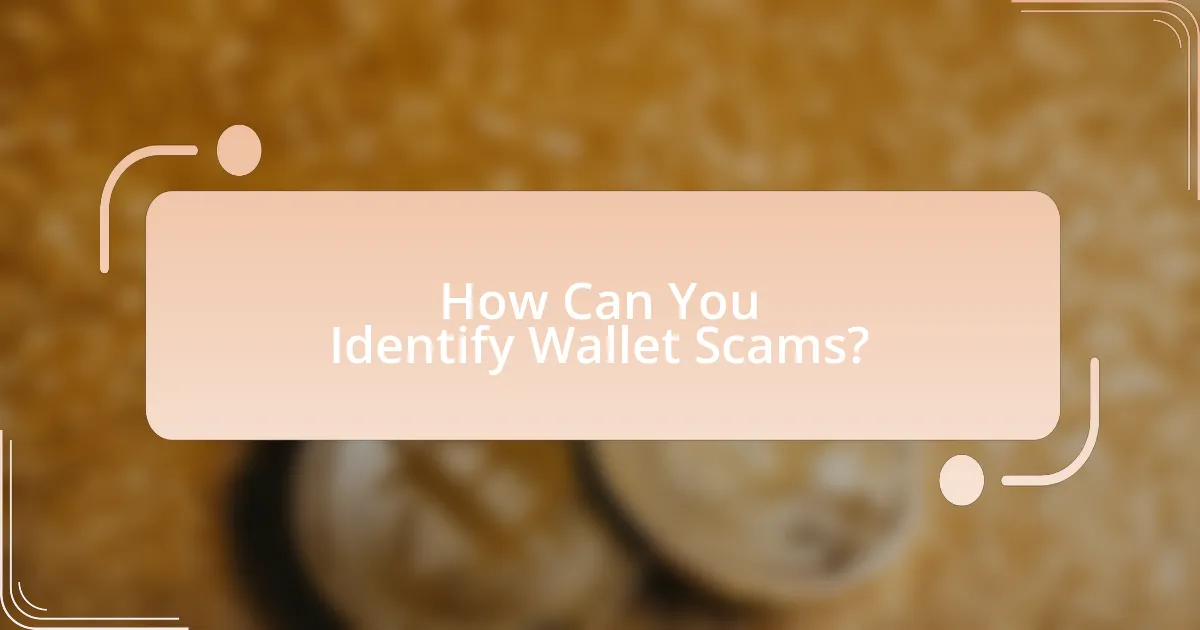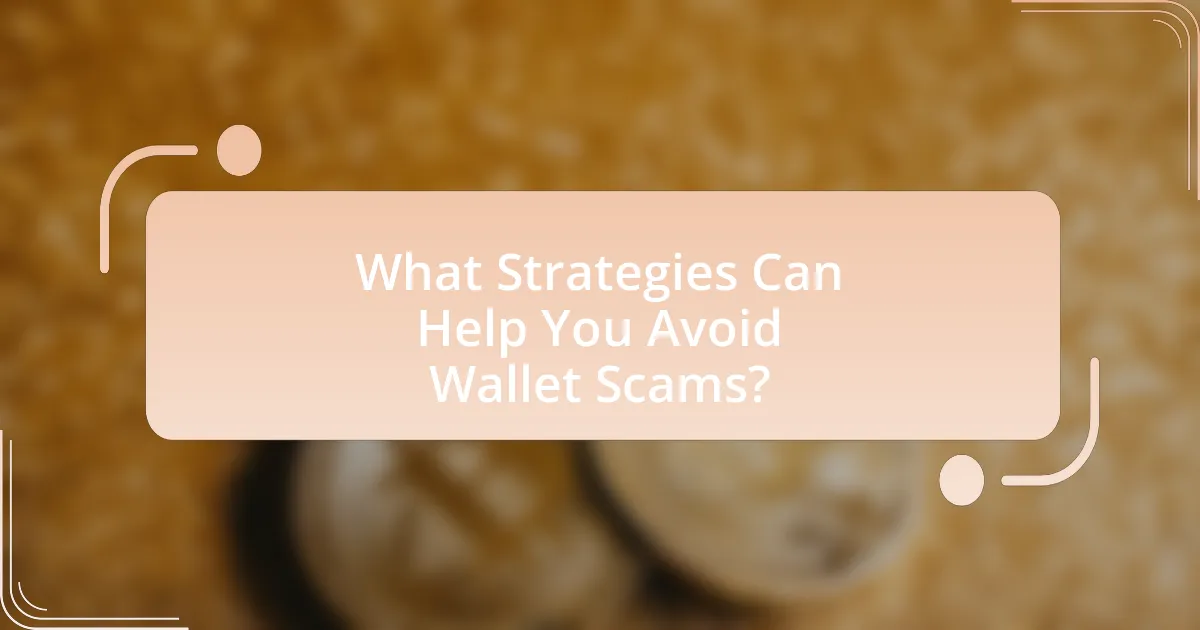The article focuses on common wallet scams and frauds, detailing various tactics employed by scammers, including phishing attacks, fake wallet applications, and social engineering schemes. It highlights the significant financial losses reported by consumers, emphasizing the importance of awareness and vigilance in recognizing red flags associated with these scams. The article also provides practical strategies for identifying fraudulent wallet services, protecting personal information, and implementing security measures such as two-factor authentication and regular account monitoring. Additionally, it discusses the broader implications of wallet scams on the financial ecosystem and offers resources for verifying wallet credibility.

What are Common Wallet Scams and Frauds?
Common wallet scams and frauds include phishing attacks, fake wallet applications, and social engineering schemes. Phishing attacks often involve fraudulent emails or messages that trick users into revealing their private keys or recovery phrases. Fake wallet applications are designed to mimic legitimate wallets but are actually tools for stealing funds. Social engineering schemes exploit trust, where scammers manipulate individuals into providing sensitive information or access to their wallets. According to the Federal Trade Commission, consumers reported losing over $1.4 billion to fraud in 2021, highlighting the prevalence and impact of these scams.
How do these scams typically operate?
Scams typically operate by exploiting trust and manipulating victims into providing sensitive information or funds. Scammers often use tactics such as impersonating legitimate organizations, creating fake websites, or sending phishing emails that appear authentic. For example, a common method involves sending messages that claim to be from a bank, prompting individuals to click on a link and enter their login credentials on a fraudulent site. According to the Federal Trade Commission, in 2022, consumers reported losing over $5.8 billion to fraud, highlighting the effectiveness of these deceptive strategies.
What tactics do scammers use to deceive victims?
Scammers use various tactics to deceive victims, including impersonation, urgency, and emotional manipulation. Impersonation involves pretending to be a trusted entity, such as a bank or government agency, to gain personal information. Urgency tactics create a false sense of immediacy, pressuring victims to act quickly without thinking. Emotional manipulation exploits feelings of fear, love, or sympathy, making victims more susceptible to scams. According to the Federal Trade Commission, in 2022, consumers reported losing over $5.8 billion to fraud, highlighting the effectiveness of these tactics.
How can technology be exploited in wallet scams?
Technology can be exploited in wallet scams through methods such as phishing, malware, and social engineering. Phishing attacks involve creating fake websites or emails that mimic legitimate services to steal users’ credentials. For instance, a report by the Anti-Phishing Working Group indicated that phishing attacks increased by 220% in 2020, highlighting the prevalence of this tactic. Malware can be used to infiltrate devices, allowing scammers to access private keys or sensitive information directly. According to cybersecurity firm Symantec, in 2019, over 1.5 million new malware variants were detected, many targeting cryptocurrency wallets. Social engineering techniques manipulate individuals into revealing personal information or transferring funds under false pretenses, with studies showing that 98% of cyberattacks rely on human error. These methods illustrate how technology facilitates wallet scams, making users vulnerable to financial loss.
Why is it important to be aware of these scams?
Being aware of scams is crucial because it enables individuals to protect their financial assets and personal information. Awareness helps people recognize red flags and avoid falling victim to fraudulent schemes, which can lead to significant financial loss. According to the Federal Trade Commission, consumers reported losing over $3.3 billion to fraud in 2020 alone, highlighting the importance of vigilance. By understanding common tactics used in scams, individuals can make informed decisions and safeguard themselves against potential threats.
What are the potential consequences of falling victim?
Falling victim to wallet scams and frauds can lead to significant financial loss and identity theft. Victims may experience direct monetary loss, with statistics indicating that the average financial loss from scams can exceed thousands of dollars per incident. Additionally, identity theft can result in long-term consequences, such as damaged credit scores and difficulties in obtaining loans or credit in the future. According to the Federal Trade Commission, identity theft reports have increased, highlighting the growing risk associated with falling victim to such scams.
How do wallet scams impact the broader financial ecosystem?
Wallet scams undermine trust in the financial ecosystem by eroding consumer confidence and increasing regulatory scrutiny. When individuals fall victim to these scams, they often experience significant financial losses, which can lead to a decrease in overall participation in digital financial services. According to a report by the Federal Trade Commission, consumers lost over $1.9 billion to fraud in 2021, with a substantial portion attributed to scams involving digital wallets. This decline in trust can result in reduced adoption of legitimate financial technologies, stifling innovation and growth in the sector. Additionally, as regulatory bodies respond to the rise in scams, they may impose stricter regulations on financial services, which can increase operational costs for businesses and limit access to services for consumers.

How Can You Identify Wallet Scams?
You can identify wallet scams by looking for red flags such as unsolicited messages asking for private keys, promises of guaranteed returns, and websites with poor security features. Scammers often create fake wallets that mimic legitimate ones, so checking for official endorsements and user reviews is crucial. Additionally, if a wallet requires excessive permissions or access to your device, it is likely a scam. According to the Federal Trade Commission, consumers reported losing over $80 million to cryptocurrency scams in 2021, highlighting the prevalence of such fraudulent activities.
What red flags should you look for?
Red flags to look for in wallet scams and frauds include unsolicited requests for personal information, pressure to act quickly, and offers that seem too good to be true. Scammers often use tactics such as creating a sense of urgency to manipulate individuals into making hasty decisions. For instance, a legitimate service will not ask for sensitive information like passwords or private keys via email or messaging. Additionally, if a wallet provider lacks transparency about fees or has poor online reviews, these are significant warning signs. According to the Federal Trade Commission, consumers reported losing over $1.9 billion to fraud in 2020, highlighting the prevalence of such scams.
How can you spot phishing attempts?
You can spot phishing attempts by looking for suspicious email addresses, poor grammar, and urgent requests for personal information. Phishing emails often come from addresses that mimic legitimate sources but contain slight variations, such as misspellings. Additionally, these emails frequently contain grammatical errors or awkward phrasing, which can indicate a lack of professionalism. Urgent calls to action, such as threats of account suspension or promises of rewards, are also common tactics used to create panic and prompt quick responses. According to the Anti-Phishing Working Group, over 90% of phishing attacks involve some form of social engineering, making awareness of these signs crucial for identifying potential threats.
What signs indicate a fraudulent wallet service?
Signs that indicate a fraudulent wallet service include lack of transparency, poor customer support, and unrealistic promises of returns. A legitimate wallet service typically provides clear information about its operations, fees, and security measures. If a service does not disclose its company information or has vague terms of service, it raises red flags. Additionally, responsive and helpful customer support is essential; if users encounter difficulties in reaching out or receiving assistance, it may indicate a scam. Lastly, if a wallet service guarantees high returns with little risk, it is likely fraudulent, as such claims are often associated with scams.
How can you verify the legitimacy of a wallet?
To verify the legitimacy of a wallet, check for official endorsements or reviews from reputable sources within the cryptocurrency community. Legitimate wallets often have a strong online presence, including a well-maintained website, active social media accounts, and positive user feedback on platforms like Reddit or Trustpilot. Additionally, ensure the wallet is open-source, as this allows for community scrutiny of its code, which can help identify potential security issues. According to a report by the Blockchain Research Institute, wallets with transparent development practices and community engagement are less likely to be fraudulent.
What resources are available for checking wallet credibility?
To check wallet credibility, users can utilize resources such as blockchain explorers, wallet review websites, and community forums. Blockchain explorers like Etherscan and Blockchair allow users to verify transaction histories and wallet balances, providing transparency. Wallet review websites, such as WalletsReview and CryptoCompare, offer evaluations and user feedback on various wallets, helping users assess their reliability. Additionally, community forums like Reddit and Bitcointalk provide platforms for users to share experiences and warnings about specific wallets, enhancing collective knowledge on wallet credibility.
How can user reviews help in identifying scams?
User reviews can help in identifying scams by providing firsthand accounts of experiences with a product or service, revealing patterns of fraudulent behavior. When multiple users report similar issues, such as non-delivery of products, poor customer service, or unauthorized charges, these consistent negative experiences serve as red flags. For instance, a study by the Better Business Bureau found that 70% of consumers rely on reviews to assess the legitimacy of a business, indicating that user feedback is a critical tool in distinguishing between trustworthy and potentially fraudulent entities.

What Strategies Can Help You Avoid Wallet Scams?
To avoid wallet scams, implement strategies such as enabling two-factor authentication (2FA), regularly updating wallet software, and using hardware wallets for storage. Two-factor authentication adds an extra layer of security, making unauthorized access more difficult. Regular updates ensure that you benefit from the latest security patches, reducing vulnerabilities. Hardware wallets, which store private keys offline, significantly lower the risk of online attacks. According to a report by the Federal Trade Commission, consumers lost over $1.9 billion to fraud in 2021, highlighting the importance of these protective measures.
How can you protect your wallet and personal information?
To protect your wallet and personal information, utilize strong passwords and enable two-factor authentication on your accounts. Strong passwords, which include a mix of letters, numbers, and symbols, significantly reduce the risk of unauthorized access. According to a study by the National Institute of Standards and Technology, using two-factor authentication can block 99.9% of automated attacks, making it a crucial step in safeguarding your information. Additionally, regularly monitor your financial statements for any unauthorized transactions and use secure networks when accessing sensitive information.
What security measures should you implement?
To avoid common wallet scams and frauds, implement multi-factor authentication (MFA) as a primary security measure. MFA significantly reduces the risk of unauthorized access by requiring multiple forms of verification, such as a password and a one-time code sent to a mobile device. According to a study by Microsoft, enabling MFA can block 99.9% of automated attacks, highlighting its effectiveness in enhancing security. Additionally, regularly updating software and using strong, unique passwords for each account further fortifies protection against potential threats.
How can you educate yourself about common scams?
To educate yourself about common scams, you can utilize reputable resources such as government websites, consumer protection agencies, and educational platforms that provide information on fraud prevention. For instance, the Federal Trade Commission (FTC) offers detailed guides and updates on various scams, helping individuals recognize and avoid them. Additionally, organizations like the Better Business Bureau (BBB) provide alerts and reports on current scams affecting consumers. Engaging with community workshops or online courses focused on fraud awareness can also enhance your understanding. According to a 2021 FTC report, consumers reported losing over $5.8 billion to fraud, highlighting the importance of education in prevention.
What best practices should you follow when using wallets?
When using wallets, it is essential to follow best practices such as enabling two-factor authentication, regularly updating software, and using strong, unique passwords. Two-factor authentication adds an extra layer of security, making unauthorized access more difficult. Regular software updates ensure that any vulnerabilities are patched, reducing the risk of exploitation. Strong, unique passwords prevent easy guessing or brute-force attacks, as studies show that weak passwords are a common entry point for fraud. Additionally, users should avoid sharing sensitive information and be cautious of phishing attempts, as these are prevalent tactics used in wallet scams.
How can you safely conduct transactions online?
To safely conduct transactions online, use secure payment methods such as credit cards or trusted digital wallets that offer buyer protection. These methods often provide fraud protection features, which can help recover funds in case of unauthorized transactions. Additionally, ensure that the website is secure by checking for HTTPS in the URL and looking for security certifications. According to a study by the Federal Trade Commission, using secure payment methods significantly reduces the risk of fraud during online transactions.
What steps should you take if you suspect a scam?
If you suspect a scam, immediately cease all communication with the suspected scammer. This includes not responding to calls, messages, or emails. Next, gather all relevant information about the scam, such as names, contact details, and any documentation related to the incident. Report the scam to local authorities, such as the police, and file a complaint with consumer protection agencies like the Federal Trade Commission (FTC) in the United States. Additionally, inform your bank or financial institution if you provided any personal or financial information. This proactive approach helps protect yourself and others from potential fraud.
What are the most effective tips for safeguarding against wallet scams?
To safeguard against wallet scams, users should implement strong security measures such as enabling two-factor authentication (2FA) and using hardware wallets for storing cryptocurrencies. Two-factor authentication adds an extra layer of security by requiring a second form of verification, significantly reducing the risk of unauthorized access. Hardware wallets, which store private keys offline, protect assets from online threats, making them less vulnerable to hacking attempts. According to a report by the Cybersecurity & Infrastructure Security Agency (CISA), using hardware wallets can mitigate risks associated with phishing and malware attacks, which are common in wallet scams.
How can regular monitoring of your accounts help?
Regular monitoring of your accounts helps identify unauthorized transactions and potential fraud quickly. By frequently checking account activity, individuals can spot discrepancies or unusual behavior, which allows for prompt reporting to financial institutions. According to a 2021 report by the Federal Trade Commission, consumers who regularly monitored their accounts were able to report fraud within a week, significantly reducing potential losses. This proactive approach not only protects financial assets but also enhances overall security against scams and fraud.
What role does two-factor authentication play in security?
Two-factor authentication (2FA) significantly enhances security by requiring two forms of verification before granting access to an account. This additional layer of security reduces the risk of unauthorized access, as even if a password is compromised, the attacker would still need the second factor, typically a code sent to a mobile device or generated by an authentication app. According to a study by Google, implementing 2FA can block 100% of automated bots and 96% of bulk phishing attacks, demonstrating its effectiveness in protecting sensitive information and preventing wallet scams and frauds.